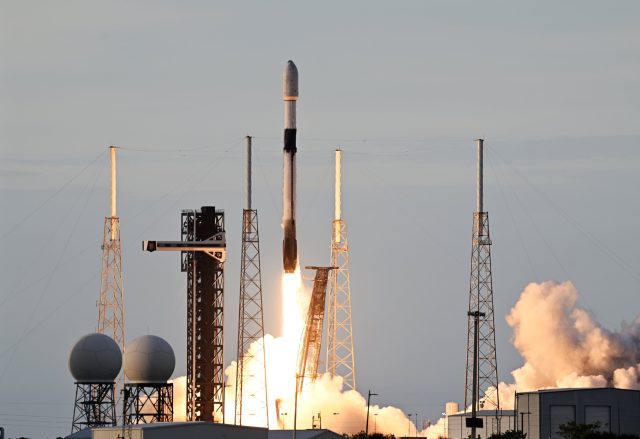Türkiye’s first indigenous communications satellite, Türksat 6A, was successfully launched into orbit by SpaceX’s Falcon 9 rocket from the U.S. state of Florida during the night from Monday to Tuesday after a brief delay due to weather conditions.
The launch was realized at 7.30 p.m. EDT (23:30 GMT) on Monday from Cape Canaveral Space Force Station, and the satellite successfully deployed at 8.05 p.m. EDT (00:05 GMT Tuesday).
The 4.25-ton satellite will operate at the 42 degrees East orbital position and its service life will be 15 years in orbit.
It will cover Türkiye, Europe, North Africa, the Middle East and Asia and serve 4.5 billion people through TV, radio and emergency communications.
Türksat 6A is the first geostationary communications satellite built by Türkiye, with development led by the Scientific and Technological Research Council of Türkiye’s Space Technologies Research Institute (TÜBITAK ÜZAY) and Turkish Aerospace Industries (TAI).
The launch has made Türkiye one of the 11 countries capable of producing satellites through their own means, the Transport and Infrastructure Minister Abdulkadir Uraloğlu said ahead of the launch.
‘Presence in space’
President Recep Tayyip Erdoğan said early Tuesday that despite obstacles and restrictions, Türkiye is expanding its presence in space, referring to the country’s newly launched homegrown satellite Türksat 6A.
Erdoğan said Türkiye also sent its Turksat 5B satellite by the same rocket two and a half years ago, adding, “We are pleased to strengthen our cooperation with Elon Musk and SpaceX in various fields.”
He said Türkiye has completed more than 81% of the subsystems and software work with domestic sources for Türksat 6A, which is important for the country’s future in the space field.
As part of its national space program, Türkiye recently realized its first manned space travel, he recalled.
With Türksat 6A, Türkiye reached a new phase in the production of satellites, Erdoğan noted. He said that Türksat 6A would increase the coverage capacity of Türkiye’s satellites, including in countries such as India, Thailand, Malaysia and Indonesia.
He also said it is significant that Türkiye can produce critical communications satellites without foreign dependence.
Vice President Cevdet Yılmaz termed the first homegrown communications satellite as “the highest-value technology project produced by our country so far.”
“Türksat 6A is a product of our national technology move, which we have implemented with a strong political will and the know-how we have acquired through our engineers and defense industry,” Yılmaz said during a ceremony in the capital of Ankara for the launching of the satellite.
Pointing out that satellite technologies, which are used in many fields such as communication, defense, weather forecasts and disaster management, also play a vital role in the security and development of countries. He said that television broadcasts, internet access and phone calls around the world are largely provided by satellites and that high-resolution imaging satellites have the capacity to monitor every point on the globe.
“We consider it extremely important to be independent in such a strategic area with domestic and national technologies,” he underlined.
Industry and Technology Minister Mehmet Fatih Kacır said Türkiye will establish an umbrella brand with the capacity to compete internationally, gathering the public company’s experience in the satellite development field.
He said that during the 6A project, in which Türkiye carried out all stages indigenously, the country achieved a localization rate of more than 80% by domestically producing 84 pieces of equipment of 23 different types, such as flight computers, power distribution and regulation units, reaction wheels, and the electric propulsion system.
“We verified the suitability of our satellite for space conditions and launch conditions with 396 environmental and functional tests carried out after system integration,” he said.
“We became one of the 11 countries that can produce their own communication satellite with all these capabilities,” he added.
Years in making
Türksat 6A has been some 10 years in the making.
Türksat 1C, the successor of the first communications satellite, Türksat 1B, was launched in 1996, followed by Türksat 2A in 2001, Türksat 3A in 2008, Türksat 4A in 2014, Türksat 4B in 2015 and Türksat 5A and 5B in 2021.
Turkish engineers participated in Türksat’s construction of the 4A and 4B satellites and in the design, production and testing phases of 5A and 5B.
The indigenous Türksat 6A project was officially launched on Dec. 15, 2014, beginning with the opening of the Space Systems Assembly Integration and Test Center established at Turkish Aerospace Industries facilities in cooperation with Türksat and Türkiye’s Defense Industry Agency.
Turkish-based defense firms, the Turkish Space Agency, Aselsan, C2TECH and Turkish Aerospace Industries, together with Turksat and TÜBITAK’s Space Technologies Research Institute, completed the satellite’s construction.
The preliminary review phase of the craft started in 2015, and the first critical review phase started the following year.
The thermal structural qualification model was completed by 2017, and the second critical review phase began in 2018, while the engineering model satellite’s construction started in 2019 and concluded in 2022.
The craft’s flight model’s initial functional and thermal vacuum tests were done the same year.
In 2023, Türksat 6A’s flight model vibration and acoustic tests, as well as its shock test and fit check, were performed.
The craft’s tests were officially finalized in 2024, and its mass properties were measured in April, followed by its delivery to the SpaceX facility in Cape Canaveral in the U.S. state of Florida on June 4.



